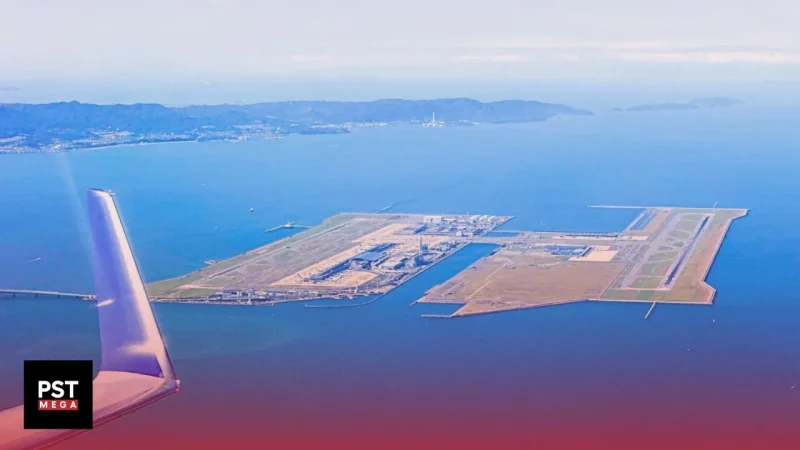Osaka is one of Japan’s large port cities and commercial centers, and it’s also home to the Kansai Airport. When this airport opened way back in 1994, it was considered an engineering marvel, as it was one of the first floating airports in the world, and cost roughly $20 billion to construct.
30 years later, the Kansai airport remains an important transport hub in Japan, and it was actually the third busiest airport in the country in 2022. But, there’s one massive problem with it: It’s sinking at an alarming rate. In fact, some experts believe that Kansai airport may be completely submerged by 2056.
The Kansai Airport’s Background
The Kansai airport was first proposed to relieve overcrowding at the first airport in Osaka, the Itami Airport. Originally, it was supposed to cost around $8 billion, but the total cost for building it skyrocketed $20 billion thanks to all the costly repairs that had to be done because the airport was sinking.
It was supposed to be an inland airport, but the ironic reason why Japan’s ministry of transportation chose to build the airport in Osaka Bay was because building the airport on land would’ve cost too much. Additionally, the ministry wasn’t willing to pay the extra costs of relocating and compensating the residents, who extremely opposed the project, that would’ve had to move from their lands to make place for building the airport. Not only that, but businesses and factories would’ve also needed to be moved, and this would’ve been very expensive.
Then, there was the problem of the environmental concerns of constructing a massive airport inland, so the project was abandoned. If only the Japanese ministry of transportation had the hindsight to see how much more costly a floating airport would be, it would’ve definitely gone with the inland airport idea.
The Construction of Kansai Airport
Before the airport’s first terminal and runway could be built, the construction team had to build an artificial island first. But, this wasn’t a major issue, as land reclamation was rapidly developing and picking up in the country following the Second World War. First, the construction team laid down sand on top of the clay seabed, and the second step involved installing a staggering 2.2 million vertical pipes, each with a diameter of 16 inches, or approximately 41 centimeters.
Once the pipes were pounded into the seabed, they were filled with moisture-absorbing sand, and this was an extremely critical step because lands reclaimed from the sea are essentially wet sponges. In other words, if the pipes failed to absorb the water in the surrounding soil and seabed, construction would be absolutely impossible, and to support the weight of the airport, a dense and dry foundation is really needed.
After the water was drained and the pipes were removed, the construction team began adding rocks and soil to the sand layer, which were brought in from nearby mountain ranges. In total, 180 million cubic meters of rocks and soil were used.
And to protect the airport’s foundation, a sea wall made of 48,000 concrete tetrapods was built around the island. The perimeter of the sea wall was built by using 69 large steel chambers, and the tetrapods were then placed in between these chambers. The sea wall was built to protect the airport from waves and surges by driving away the oncoming water, and this means that without the sea wall, the airport would be completely drowned in water from the Osaka Bay.
Eventually, the island reached a height of 65 million feet, or 19.8 million meters, above sea level, and that’s when construction on it stopped. The engineers should’ve built it even higher, but they’ve seriously underestimated how fast, and how much, the island would sink.
Once the island was completed and stabilized, the construction team began working on the airport’s terminal and runway, and in 1990, a three-kilometer bridge connecting the island to Rinku Town in Osaka was built, and this bridge also came with an expensive price tag, costing about $1 billion to build.
The main terminal building was designed by the famed Italian architect Renzo Piano, and his notable works include the Centre Georges Pompidou in Paris and the Whitney Museum of American Art in New York City. He had a unique vision for the airport, but his plan almost didn’t come to fruition because the government wanted a shorter terminal to reduce the cost. But, Piano insisted on his plans, and the terminal was built to become 1.7 kilometers long, and was the longest in the world back then.
The Opening and Expansion
The airport was opened in 1994 with much fanfare, but this didn’t last for long because soon enough after the airport’s opening day, the island with the first terminal started sinking because the weight of the island and the airport built on top of it started compressing the seabed silts.
But, engineers were convinced they had everything under control, so construction on a second terminal started and a second runway started in 2003. They were built on a second island that was built using the same process as the first island, but what was different is that engineers adjusted their measurements because they knew this island would sink just as much as the first.
The second island was built because Japanese officials thought an expansion was necessary as tourism in Japan was increasing at an extremely rapid pace, with the Narita International Airport and the Tokyo Haneda Airport, the country’s first and second busiest airports, were always extremely congested. Additionally, Japan wanted to position the Kansai airport as a gateway to all of Asia, and didn’t want to lose customers to other major airports in the region like those in South Korea and Hong Kong.
Japan’s Response to the Problem
The engineers were confident because they expected the islands to evenly settle over the upcoming 50 years and stabilize themselves at 13 feet above sea level, which is the minimum elevation required to stop serious flooding. But, their calculations were a bit off. Fast forward to 2018, the Kansai airport had already sunk 38 feet since its construction, 52% more than what engineers anticipated, as they thought that the first island would sink 19 to 25 feet.
The engineers optimistically used the lower end of their estimates during construction, and now the airport is paying the price, but the Japanese government is also paying the price, spending more than $150 million on the sea wall to prevent the airport from sinking completely.
As you’d expect, Japan is taking more measures than just raising the sea wall. For example, the construction team excavated the ground below the passenger terminal, and inserted a series of iron plates directly underneath the hydraulic jacks and the 900 column foundation.
This allowed the engineers to raise the foundation’s columns in stages, which slowed the sinking considerably. But, it didn’t eliminate the problem, and was just a temporary solution. Not only that, but the hydraulic jacks underneath the airport need to be adjusted every two years, and all the team could do is install meters on the columns to measure how much the airport is tilting.
The Future of The Kansai Airport
Clearly, if Japan fails to come up with something that will fix the problem permanently, then the airport will be abandoned as it’ll eventually sink, and maybe a new Kansai airport will be built, but this time on land.
And as the climate problems worsen, the airport’s future looks even more grim. In fact, in 2018, the airport was hit by Typhoon Jebe, which was considered the strongest storm to hit Japan in 25 years, and the damage to the airport was so severe that the airport had to pause operations completely.
Even though it’s sinking, the airport remains a modern engineering wonder in our opinion, especially when you consider the fact that it took just seven years to complete.
Whether Japan currently has a solution for the problem or not, the country’s outlook for the airport seems to be positive, as the airport continues to expand. In fact, in December 2023, a new international departure area was opened, with future expansions set to be completed by 2025. Are these calculated expansions with a solution for the problem in mind? Or more engineering mistakes? Only time can tell.
Disclaimer
Please visit and read our disclaimer here.









